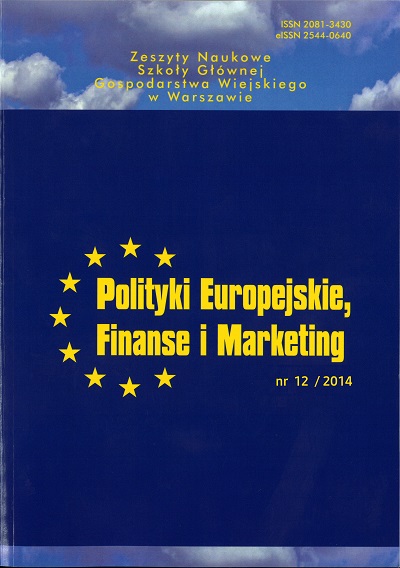Main Article Content
Celem artykułu było określenie pozycji konkurencyjnej polskich i słowackich produktów rolno-spożywczych na rynku europejskim, a także, dla celów porównawczych, na rynkach krajów trzecich oraz w odniesieniu do innych grup produktów. Ponadto, przedstawiono zmiany w konkurencyjności tego sektora. Wydajność konkurencyjna w handlu rolno-spożywczym Polski i Słowacji została oceniona za okres 1999-2012. Teorie handlu wskazują, że kraje specjalizują się w produkcji dóbr, handlują nimi i osiągają lepszą pozycję konkurencyjną, jeśli mają przewagi absolutne lub komparatywne w porównaniu do swoich partnerów (Ricardo 1957, Balassa 1965, Lall 2001, Guzek 2006). W celu określenia pozycji konkurencyjnej zastosowano przewagę komparatywną i ocenę handlu rolno-spożywczego. Analiza uwzględnia dwa wskaźniki: ujawnioną przewagę komparatywną (RCA) oraz wskaźnik eksportu netto (NEI). Po przystąpieniu do Unii Europejskiej znaczenie handlu zagranicznego produktami rolno-spożywczymi w obu tych krajach wzrosło na rynku europejskim, jednak na rynku krajów trzecich wzrosty odnotowała jedynie Polska. Wskaźnik RCA (revealed comparative advantage) w tych krajach jest znacząco różny. W Polsce zaobserwowano przewagę komparatywną, podczas gdy na Słowacji jej nie było. Podobna sytuacja dotyczy wskaźnika net export index (NEI). Pozytywną wartość wskaźnika eksportu netto dla produktów rolno-spożywczych stwierdzono jedynie w Polsce. [Tłum. LW]
Article Details
AMITI, M. 1999. Specialization patterns in Europe. Weltwirtschaftliches Archiv 135. 573-593. (Crossref)
BALASSA, B. (1965). Trade Liberalization and "Revealed" Comparative Advantage. Manchester School of Economic and Social Studies 33: 99-124. (Crossref)
BOJNEC, Š. - FERTŐ, I. 2008. European Enlargement and Agro-Food Trade. In Canadian Journal of Agricultural Economics, vol. 56, 2008, no. 4, 563-579. (Crossref)
KISS, J. 2011. Some impacts of the EU accession on the new member states' agriculture. In Eastern Journal of European Studies, vol. 2, 2011, no. 2, 49-60.
KLINGER, B. (2010). (New) Export Competitiveness. Mimeo. Center for International Development, Harvard University, February, 2010.
KRUGMAN, P. (1994). Competitiveness: a dangerous obsession. Foreign Affairs 73(2): 28-44. (Crossref)
BOLTHO, A. 1996. The Assessment: International Competitiveness. Oxford Review of Economic Policy, 12(3), 1-16. (Crossref)
FAGERBERG, J. 1988. International competitiveness. The Economic Journal Vol.98. No.391 (Crossref)
GUZEK, M. 2006.Międzynarodowe stosunki gospodarcze. Zarys teorii i polityki handlowej. PWE. ISBN:83-208-1611-4.
FERTŐ, I. 2008. The evolution of agri-food trade patterns in Central European countries. In Post- Communist Economies, vol. 20, 2008, no. 1, 1-10. (Crossref)
FERTÖ, I. - HUBBARD, J. 2003. Revealed Comparative Advantage and Competitiveness in Hungarian Agri-Food Sectors. The World Economy. Volume 26, Issue 2, pages 247-259. (Crossref)
HORSKÁ, E. - UBREŽIOVÁ, I. 2006. International Managment and Markerting In Regional Trade within V4 countries: focus on Slovak - Hungarian trade flows. EconPapers. Theory Methodology Practice (TMP), 2007, vol. 4, issue 01, pages 25-38. doi: http://econpapers.repec.org/article/mictmpjrn/v_3a4_3ay_3a2007_3ai_3a01_3ap_3a25-38.htm
LALL, S. 2001. Competitiveness Indices and Developing Countries: An Economic Evaluation of the Global Competitiveness Report. World Development 29 (9): 1501-1525. (Crossref)
LALL, S. - ALBALADEJO, M. (2004). China's Competitive Performance: A Threat to East Asian Manufactured Exports? World Development 32 (9): 1441-1466. (Crossref)
LEE, J. (1995). Comparative Advantage in Manufacturing as a Determinant of Industrialization: The Korean Case. World Development 23 (7): 1195-1214. (Crossref)
MINTZBERG, H. 2009.Managing. Berrett-Koehler Publishers, Inc. San Francisco. ISBN: 979-1-57675-340-8, 196-225.
NOSECKA, B. - PAWLAK, K. - POCZTA, W. 2011. Wybrane aspekty konkurencyjności rolnictwa. Konkurencyjność Polskiej Gospodarki w Warunkach Globalizacji i Integracji Europejskiej.IERGiŻ. Warsaw 2011. No.7.ISBN: 978-83-7658-148-4.
UBREŽIOVÁ, I. - KAPSDORFEROVÁ, Z. - SEDLIAKOVÁ I. 2012. Competitiveness of Slovak agri-food commodities in third country markets 386Acta Univ. Agric. Silvic. Mendelianae Brun. 2012. Vol. 60, Issue 4, pp. 379- 386. doi: http://dx.doi.org/10.11118/actaun201260040379 (Crossref)
PORTER, M. E. 1990. The Competitive Advantage of Nations. The Free Press. A Division of Macmillan Inc. New York. ISBN: 0-684-84147-9
RICARDO D. 1957. Zasady ekonomii politycznej i opodatkowania, PWN, Warszawa.
RYTKO, A. 2008. Zmiany konkurencyjności polskich produktów żywnościowych w latach 2000-2007, Scientific Journals WULS, Warsaw 2008. Problemy Rolnictwa Światowego Tom 5(XX), str.153-161. (Crossref)
RYTKO, A. 2012. Competitiveness and its source in foreign trade between the EU and the United States, Actual Problems of Economics 2012, 2(10), 25-34
TOROK, A. - JAMBOR, A. 2012. Changes in Agri-Food Trade of the New Member States since EU Accession - A Quantitative Approach. Selected Poster prepared for presentation at the International Association of Agricultural Economists (IAAE) Triennial Conference, Foz do Iguaçu, Brazil, 18-24 August, 2012.
WESLEY, E. - PETERSON, F. - VALLURU, S. R. K. 2000. Agricultural Comparative Advantage and Government Policy Interventions. Journal of Agricultural Economics. Volume 51, Issue 3, pages 371-387. (Crossref)
Downloads
- Łukasz Paluch, Studium uwarunkowań rozwoju rolnictwa i organizacji produkcji rolniczej w Regionie Małopolska , Zeszyty Naukowe SGGW, Polityki Europejskie, Finanse i Marketing: Nr 12(61) (2014)
Możesz również Rozpocznij zaawansowane wyszukiwanie podobieństw dla tego artykułu.
- Anna Rytko, Wspólna Polityka Rolna i jej efekty po wdrożeniu reformy z 2003 roku , Zeszyty Naukowe SGGW, Polityki Europejskie, Finanse i Marketing: Nr 8(57) (2012)

Utwór dostępny jest na licencji Creative Commons Uznanie autorstwa – Użycie niekomercyjne 4.0 Międzynarodowe.





